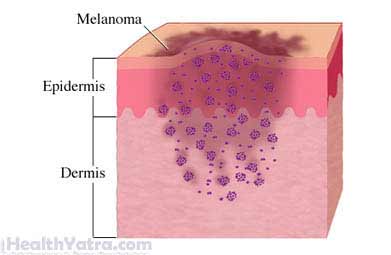সংজ্ঞা
Melanoma removal is a surgery to remove cancer in skin tissue. The cancer is calledmelanoma.

পদ্ধতির কারণ
A melanoma removal is done to treat melanoma. For some it may be a cure for melanoma.
সম্ভাব্য জটিলতা
Complications are rare, but no procedure is completely free of risk. If you are planning to have a melanoma removal, your doctor will review a list of possible complications, which may include:
- সংক্রমণ
- রক্তপাত
- নার্ভ ক্ষতি
- দাগ
- Incomplete removal of all cancerous কোষ
- Recurrence or spread of cancer
Smoking may increase the risk of complications.
কি আশা করছ
পদ্ধতির আগে
Depending on the stage of the disease, your doctor may do the following:
- Physical exam of skin
- Biopsy of any suspicious lesion
- রক্ত পরীক্ষা
- Image tests such as Chest x-ray, CT scan, MRI, or PET scan
এনেস্থেশিয়া
Local anesthesia is often used to numb the area where the cancer is removed.General anesthesia may need to be used if the area is large. In this case, you will be asleep.
পদ্ধতির বর্ণনা
Surgical removal of the cancerous cells is the primary treatment for melanoma. Types of surgery অন্তর্ভুক্ত:
- Simple excision—The tumor is cut out, along with a small amount of normal skin at the edges. The wound is stitched back together. This অস্ত্রোপচারের ধরন may leave a scar.
- Wide excision—The tumor is cut out along with a larger area of normal skin. This will help make sure there are no cancer cells left behind.
- Amputation—A finger or toe may be removed if the cancer is on the digit.
- Lymph node dissection—Nearby lymph nodes may be removed if there is concern that the cancer spread. The removed lymph nodes will be sent to a lab for study.
The area may be closed with stitches. A larger area may need to be covered with a skin graft from another area of your body.
পদ্ধতির পরে
In more advanced cases of melanoma, other treatments may be necessary. These include:
- কেমোথেরাপি
- বিকিরণ থেরাপির
- ইমিউনোথেরাপি
এতে কতক্ষণ সময় লাগবে?
This depends on the extent of the melanoma and the type of surgery. Simple excision can take less than one hour.
এটা আঘাত করবে?
Anesthesia prevents pain during the procedure. You may have some pain around the wound during recovery. Medicine will help manage pain.
পোস্টোপারেটিভ কেয়ার
- Keep the surgical area clean, dry, and protected by bandages.
- If recommended by your doctor, apply a nonprescription antibiotic ointment to the wound before applying bandages.
- Take any medications as prescribed.
- Avoid vigorous ব্যায়াম according to your doctor’s recommendations.
- Return to have any stitches or staples removed when instructed.
- কখন গোসল করা, গোসল করা বা জলে ভিজানো নিরাপদ সে সম্পর্কে আপনার ডাক্তারকে জিজ্ঞাসা করুন।
Talk to your doctor about appropriate ways to protect your skin against sun damage. These may include using sun block and wearing protective clothing. You will also need to have regular skin exams to look for the return of cancer cells. Do self-exams to look for any new or changing moles. Your doctor can show you how to do a self-exam.
আপনার ডাক্তারকে কল করুন
After arriving home, contact your doctor if any of the following occur:
- জ্বর এবং ঠাণ্ডা সহ সংক্রমণের লক্ষণ
- লালভাব, ফোলাভাব, ক্রমবর্ধমান ব্যথা, অত্যধিক রক্তপাত, বা ছেদ স্থান থেকে কোনো স্রাব
- Pain that you can’t control with the medications you’ve been given
- A new lump or discoloration in your skin
- A change such as color, bleeding, itching, or growth in an already-existing mole, either at the surgical site or in a new location
- Any other new or concerning symptoms
জরুরী পরিস্থিতিতে, অবিলম্বে চিকিৎসা সহায়তার জন্য কল করুন।
